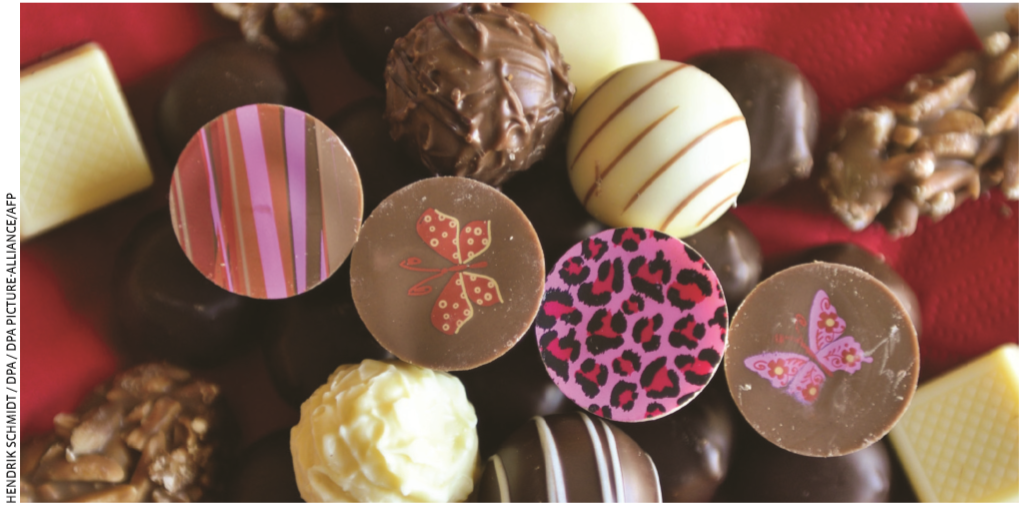Inglês: Interpretação – Chocolate craving comes from total sensory pleasure
The combination of the smoothness and creaminess in the mouth, the smell and the sweetness make chocolate-eating a hugely pleasurable experience

A RECENT STUDY suggests that chocolate cravings are not a modern phenomenon. In fact, it may date back to the 18th century and beyond
15For most of us, chocolate is a guilty pleasure. We crave it because it tastes wonderful and sweet – although we know we should really be stretching for the fruit bowl. 10The British are particularly 1fond of chocolate. Research shows that, on average, Britons enjoy about 11 kg of chocolate a year, making the UK one of the biggest consumers of chocolate in the world. Only the Swiss and Germans eat more. But a recent study suggests that chocolate cravings are not a modern phenomenon. In fact, chocoholism may date back to the 218th Century and beyond.
Cacao beans, which are the basic component of chocolate, 11were roasted, ground and drunk with water by the Mayans from around 2,000 years ago. In the 314th century, the Aztecs concocted chocolate drinks with flavourings and used the beans to treat a number of common ailments. Then in the late 1700s in Mexico, 12a young doctor started seeing chocolate as 4harmful, rather than medicinal. He blamed an increase in hysteria among women and nuns in several cities on their excessive consumption of chocolate. Was this 7actually an extreme form of chocolate craving?
According to a paper presented at the International Congress on the History of Science, Technology and Medicine at the University of Manchester this weekend, cacao was very popular at the time and could be served hot or cold for medicinal or pleasure purposes. 9Nuns were particularly privileged, says author Dr. Mauricio Menchero, and 8they “were able to have as much chocolate as they wished for regardless of costs”. Even a sharp rise in the price of chocolate did not affect consumption levels in convents, he says. So when new laws were brought in which forced nuns to 13do away with personal servants and make their own food and drinks, their
intake of cacao was “greatly diminished” and they were afflicted by hysterical attacks. (…)
The bitter, dark chocolate eaten by the nuns is nothing like the 5sugary, flavoured milk chocolate which is popular today – but the reaction is understandable. Many people would claim to crave chocolate and enjoy the feeling that eating it induces. The key to this may be a chemical called anandamide, which is similar to the compounds released when cannabis is taken. Anandamide is released in small quantities when we eat chocolate and it creates a relaxing feeling.
Prof. Philip Wilson, author of Chocolate as Medicine – A Quest over the Centuries, says what lies behind the aphrodisiac qualities of chocolate is still to be answered. “It’s difficult to tease apart which chemicals may be contributing to which psychological functions. There are over 500 chemicals in consumer chocolate products, so there’s a lifetime of chemical analysis still to be done”, says Prof. Wilson. His hunch is that the “almost seductive” texture of chocolate is as important as its ingredients.
Dr. Barry Smith, director of the Centre for the Study of the Senses at Birkbeck University of London, agrees. He says the combination of the smoothness and creaminess of chocolate in the mouth, the sweetness of the taste and the smell of it before it even hits the taste buds make chocolate-eating a hugely 6pleasurable experience. As for whether chocolate can actually improve our mood, there is limited evidence according to neuroscientists. 14But millions of women (and nuns) can’t be wrong, can they?
By Philippa Roxby. Texto adaptado. Disponível em <https://www.bbc.co.uk/news/health-23449795>. Acesso em 01/08/2013.
Exercícios – UEM 2013 (adaptado)
As questões a seguir apresentam múltiplas alternativas. Oriente-se pelas referências numéricas do texto principal, marcadas nas questões. A cada questão, aponte as alternativas corretas.
1. About the extract “For most of us, chocolate is a guilty pleasure. We crave it because it tastes wonderful and sweet – although we know we should really be stretching for the fruit bowl” (ref. 15), it is correct to say that
a) the majority of people feel that eating chocolate is both good and bad.
b) the verb “crave” expresses a strong desire for something.
c) the conjunction “although” is used to add extra information to what has been said.
d) the modal verb “should” is used to show that something is the best thing to do because it is good for you.
e) “fruit bowl” is a type of chocolate that has fruit flavours.
2. Choose the alternative(s) in which the information about the word(s) extracted from the text is correct.
a) “fond of” (ref. 1) is the same as “greedy” and means “wanting more food or drink than you need”.
b) The “th”, as in “18th century” (ref. 2) and “14th century” (ref. 3), is used in English to form most ordinal numbers.
c) The adjectives “harmful” (ref. 4), “sugary” (ref. 5) and “pleasurable” (ref. 6) describe the good properties of chocolate.
d) The adverb “actually” (ref. 7) can be translated into Portuguese as “atualmente”.
e) The pronoun “they” (ref. 8) refers to “Nuns” (ref. 9).
3. According to the text, choose the correct alternative(s).
a) Chocolate is the most consumed eating product in the whole world, mainly in Switzerland and Germany.
b) The addiction to chocolate can be stronger than drug dependence in physical and psychological aspects.
c) Cacao beans are the natural raw material of chocolate.
d) The lack of cacao was one of the main causes of women’s psychological disturbance among the Aztecs.
e) According to research, there was evidence that the desire for chocolate already existed three centuries ago.
Respostas
1. “Para a maioria de nós, chocolate é um prazer cheio de culpa. Nós o ansiamos porque ele é maravilhosamente saboroso e doce – embora saibamos que devêssemos realmente optar por algo na tigela das frutas”. Disso se tira que:
a) A maioria das pessoas sente que comer chocolate é ao mesmo tempo bom e ruim. Correta.
b) O verbo “to crave” tem sentido de “ansiar”, “desejar fortemente”. Correta.
c) O conector “although” tem sentido concessivo, ideia contrastiva,não aditiva. Incorreta.
d) O verbo “should” é usado com a ideia de recomendação. Correta.
e) Tigela de frutas não é um tipo de chocolate com sabor de frutas. Incorreta.
Resposta: A, B, D
2. Dadas as alternativas:
a) A expressão “to be fond of” tem sentido de “gostar ou gostar muito”, ao passo que “greedy” tem um sentido pejorativo, de ganancioso. Logo não tem o mesmo sentido. Incorreta.
b) O indicador ordinal “th” é oriundo do sufixo de alguns números ordinais em inglês. Ex.: eighteenth. Correta.
c) “Sugary” (adocicado) e “pleasurable” (agradável) descrevem as propriedades boas do chocolate. “Harmful” (prejudicial) não pode ser uma delas. Incorreta.
d) “Actually” é um falso cognato comum nas provas e exames e significa “realmente”, “verdadeiramente”. Atualmente é “nowadays”. Incorreta.
e) Veja o trecho: “Nuns were particularly privileged, says author Dr. Mauricio Menchero, and they ‘were able to have as much chocolate as they wished for regardless of costs’.” (As freiras eram notavelmente privilegiadas, diz o autor […] e elas eram capazes ter tanto chocolate quanto quisessem, independentemente dos custos.). Correta.
Resposta: B, E
3. A respeito das afirmações:
a) Extrapola o texto ao afirmar que o chocolate é o produto alimentício mais consumido no mundo. Incorreta.
b) Outra extrapolação do texto. Não há no texto referência sobre o vício em chocolate ser mais forte do que a dependência de drogas quanto aspectos físico-patológicos. Incorreta.
c) A s sementes de cacau são a matéria-prima do chocolate e o texto afrma isso no trecho: “Cacao beans, which are the basic component of chocolate”. Correta.
d) Não há menção de que a falta de cacau foi uma das principais causas de distúrbios psicológicos das mulheres astecas. Incorreta.
e) O trecho “Chocoholism may date back to the 18th century and beyond” confrma que já havia o desejo por chocolate no século XVIII. Sendo assim, três séculos atrás. Correta.
Resposta: C, E




















